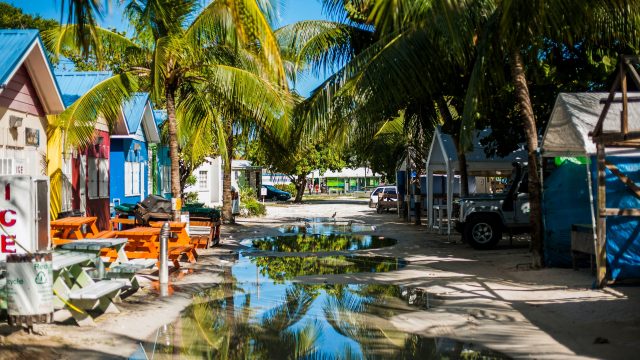Assessing the real risk of sovereign bonds

Sovereign bonds make up a huge 40% of the global bond market. Traditionally, they have been seen as a reliable and low-risk investment of choice by investors. Yet, amazingly, the bonds are rarely assessed in terms of their exposure to environmental risk. All that could now change.
Humanity’s growing consumption of natural resources and ecological services is testing our planetary boundaries. Total human consumption of renewable natural resources and services is already one and a half times greater than the capacity of the biosphere to supply them. In other words, it takes the planet 18 months to generate the food, fibre, timber products, and carbon sequestration services that are consumed in one year.
As a result, we are drawing down our stocks of natural capital with potentially severe consequences for both economic performance and human well-being. These risks are still, however, broadly unrecognised in financial risk analysis.
A new methodology aims to change this by demonstrating that environmental risks are both quantifiable and significant in economic terms. The ERISC methodology was developed by Global Footprint Network in partnership with UNEP FI, and with the active participation of 15 financial institutions, to explore the financial materiality of natural resource risks in the context of sovereign credit risk assessment. By providing robust analysis and simple metrics, ERISC aims to promote better integration of environmental risks in financial risk analysis.
Financial institutions would benefit from such integration as it represents a refinement and broadening of the coverage of their risk analysis. The results also have important implications for countries. Indeed, the integration of environmental risks in the country risk assessments of financial institutions will send a strong signal and may even lead to increasing costs of borrowing or insurance for countries with high exposure to these risks. This would constitute a powerful incentive for change towards improved resource management that takes account of planetary boundaries.
ERISC – Environmental Risk Integration in Sovereign Credit
While there is growing recognition within the financial sector of the need to integrate more extra-financial considerations in risk analysis, the integration of environmental factors, particularly at a country level, has remained poor. This is in part due to the lack of metrics with proven financial materiality as well as adequate coverage and consistency. The methodology was designed specifically to address this gap, focusing on natural resource-related risks in particular.
The ERISC methodology aims to answer one main question: How material are natural resource risks for a country?
To answer this question, the methodology relies heavily on Ecological Footprint accounting, a tool that compares the resource consumption of countries with the ability of their ecosystems to provide them. By using this approach, a typology of risks can be established based on a country’s natural resource production, consumption, and trade patterns. In addition to renewable natural resources and services that are accounted for by the Ecological Footprint, the methodology also considers non-renewable natural resources such as fossil fuels, ores and minerals to provide a complete picture of the countries’ resource situation.
Once the countries’ natural resource situation is established, the second component of the methodology considers the economic exposure to these environmental risks. Depending on how important natural resource-intensive sectors are in the country’s economy, the impacts of resource-related risks will vary in magnitude. The third and final component of the methodology assesses the financial situation of the economy to evaluate its resilience to the external shocks that could occur as a result of the risks described in the first two components. A country with high debt levels, imbalanced trade or persistent inflation may be less able to absorb such shocks.
The results can inform detailed country analyses or be distilled to a handful of key indicators allowing comparison and ranking of country risk profiles. This broad range of qualitative and quantitative information generated by the analysis offers many potential uses and avenues for integration in existing risk assessment frameworks.
“ By proving that unsustainable consumption and production patterns lead to real economic risks, and having these risks factored in to the countries’ borrowing costs, the framework demonstrates to countries that addressing these issues is in their self-interest.”
The methodology is still in development and has, to date, only been applied in full to five countries: Brazil, France, India, Japan and Turkey. This has however been sufficient to generate a number of key findings:
- The framework is capable of capturing the wide variety of resource profiles that countries possess. Countries are not equal in their resource endowments and neither are they in resource management or resource-intensity of consumption. Brazil, for example, has 20 times more biocapacity (a measure of the biosphere’s regenerative capacity) per capita than India. Nonetheless, India mostly relies on its own biocapacity while Japan demands seven times more biocapacity than it has available but mostly makes up the shortfall through imports. The framework captures these differences and their consequences in terms of risk exposure.
- The framework demonstrates the materiality, or significance, of natural resource-related risks for countries’ macroeconomic performance. It notably establishes how the growing reliance on imports to meet demand for natural resources and services can translate into exposure to commodity price volatility and how environmental degradation can lead to falling agricultural productivity that needs to be compensated through imports. In some cases, negative effects on the balance of trade could reach the equivalent of several percent of the country’s GDP.
- Contrary to an often-expressed belief, the results of the framework show that environmental risks are not only a long-term concern. Risks on the trade side can materialise very suddenly as a result of price movements or policy decisions such as export restrictions. Even risks that are linked with more cumulative drivers can materialise very suddenly. Ecosystem collapse or extreme climatic events aggravated by climate change may indeed result from a long-term overburdening of ecosystems’ capacity to provide resources or services, yet these phenomena are subject to important threshold effects and other non-linear reactions that make them highly unpredictable. By using a probabilistic model based on past trends as well as current situations, the ERISC framework generates results that are relevant even in short time-frames.
Influencing financial decisions to promote change
The ERISC methodology has been presented in a public report launched at Bloomberg in London in November 2012. Although the framework is still in development and the results still tentative, there has been considerable interest from the financial community, suggesting real potential for improved integration of environmental risks in financial risk analysis.
While this represents an important success, the ambitions of this work are greater still. By proving that unsustainable consumption and production patterns lead to real economic risks, and having these risks factored in to the countries’ borrowing costs, it demonstrates to countries that addressing these issues is in their self-interest. Indeed, it may even be essential if they are to provide for the well-being of their population in an era of growing ecological constraints.
Martin Halle, Policy Analyst, Global Footprint Network


